Blood pheasant
The blood pheasant (Ithaginis cruentus) is the only species in genus Ithaginis of the pheasant family. It is a relatively small, short-tailed pheasant that is widespread and is fairly common in eastern Himalayas, ranging across India, Nepal, Bhutan, China and northern Myanmar. Since the trend of the population appears to be slowly decreasing, the species has been evaluated as Least Concern by IUCN in 2009.[1]
| Blood pheasant | |
|---|---|
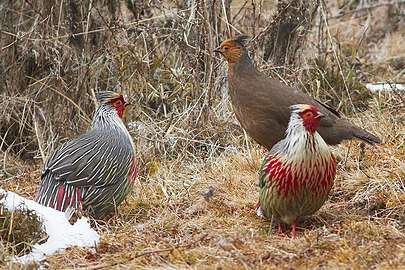 | |
| A flock from Phrumsengla National Park, Bhutan | |
| Scientific classification | |
| Kingdom: | Animalia |
| Phylum: | Chordata |
| Class: | Aves |
| Order: | Galliformes |
| Family: | Phasianidae |
| Genus: | Ithaginis Wagler, 1832 |
| Species: | I. cruentus |
| Binomial name | |
| Ithaginis cruentus (Hardwicke, 1821) | |
| Synonyms | |
|
Ithaginis cruentatus | |
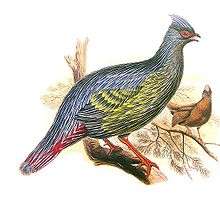
The blood pheasant was the national bird of the former Kingdom of Sikkim,[2] and remains Sikkim's state bird.[3]
Description
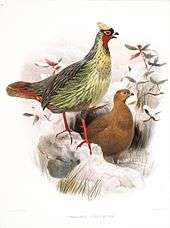
Blood pheasants have the size of a small fowl, about 17 in (43 cm) in length with a short convex, very strong black bill, feathered between bill and eye, and a small crest of various coloured feathers. The colour of the plumage above is dark ash, with white shafts, the coverts of the wings various tinged with green, with broad strokes of white through the length of each feather, the feathers of the chin deep crimson; on the breast, belly and sides feathers are lance-shaped, of various length, the tips green with crimson margins, collectively resembling dashes of blood scattered on the breast and belly. The tail consists of twelve sub-equal feathers, shafts white, rounded, the ends whitish, the coverts a rich crimson red.[4]
Both males and females have red feet and a distinct ring of bare skin around the eye that typically is crimson colored, but is orange in a few subspecies. Females are more uniformly colored, being overall dull brown and often with some gray to the nape. Although some of the subspecies that have been described are highly distinctive, others are not, and some variation appears to be clinal. Consequently, the number of valid subspecies is disputed, with various authorities recognizing between 11 and 15. They mainly vary in the plumage of the males, especially the amount of red or black to the throat, forehead, neck, chest and tail, and the presence or absence of rufous in the wings.[5]
Taxonomy
Subspecies
There are twelve recognized subspecies:
- I. c. affinis (CW Beebe, 1912) - Sikkim region in India
- I. c. beicki (Mayr and Birckhead, 1937) - Beick's blood pheasant - north central China
- I. c. berezowskii (Bianchi, 1903) - Berezovski's blood pheasant - mountains of central China
- I. c. clarkei (Rothschild, 1920) - Clarke's blood pheasant - southwest China
- I. c. cruentus (Hardwicke, 1821) - Himalayan blood pheasant - northern Nepal to northwestern Bhutan
- I. c. geoffroyi (Verreaux, 1867) - Geoffroy's blood pheasant - western China and southeast Tibet
- I. c. kuseri (Beebe, 1912) - Kuser's blood pheasant - upper Assam in India and southeast Tibet
- I. c. marionae (Mayr, 1941) - Mrs. Vernay's blood pheasant - mountains of southwest China and northeast Myanmar
- I. c. michaelis (Bianchi, 1903) - Bianchi's blood pheasant - north central China
- I. c. rocki (Riley, 1925) - Rock's blood pheasant - southwestern China
- I. c. sinensis (David, 1873) - David's blood pheasant - central China
- I. c. tibetanus (ECS Baker, 1914) - Tibetan blood pheasant - eastern Bhutan and southern Tibet
Distribution and habitat
Blood pheasants live in the mountains of Nepal, Sikkim, northern Myanmar, Tibet, and central and south-central China, where they prefer coniferous or mixed forests and scrub areas near the snowline. They move their range depending on the seasons, and are found at higher elevations during the summer. With snow increasing in fall and winter they move to lower elevations.[5]
References
- BirdLife International (2012). "Ithaginis cruentus". IUCN Red List of Threatened Species. 2012. Retrieved 26 November 2013.CS1 maint: ref=harv (link)
- Verma, Rajesh (1999). Sikkim: A Guide and Handbook : with Road, Town, and Trekking Maps. Gangtok, India: S. Verma. p. 130. ASIN B0006FEJ74.
- Kazmierczak, Krys; Singh, Raj (1998). A Birdwatchers' Guide to India. London, UK: Prion. p. 137. ISBN 978-1-871104-08-0.
- Hardwicke, T. (1821). "Descriptions of a Wild Dog of Sumatra, a new Species of Viverra, and a new Species of Pheasant". The Transactions of the Linnean Society of London. Linnean Society of London. XIII: 235–238.
- Johnsgard, P. A. (1999) The Pheasants of the World: Biology and Natural History. Washington, D.C: Smithsonian Institution Press
External links
| Wikimedia Commons has media related to Ithaginis cruentus. |
Images


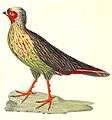

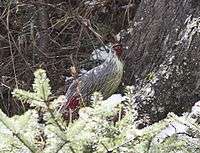
 Kuser's Blood Partridge
Kuser's Blood Partridge Northern Blood Partridge
Northern Blood Partridge Sikhim Himalayan Blood Partridge
Sikhim Himalayan Blood Partridge Himalayan Blood Partridge
Himalayan Blood Partridge

